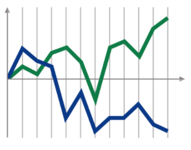
Consumers need to see your ads and remember them for your business to grow. At the same time, you do not want to show people too many ads too quickly, as that can turn them away before they become customers. Running your ads at the optimal frequency is critical to ensure you reach interested customers without overloading them.
Ad frequency is one of the most complicated metrics you will deal with as you manage your ad spend. By looking at these critical elements of your ad campaign, you can adjust your ad frequency to improve your campaigns’ performance.
Your Ad Frequency Depends On Your Channels
 There’s no single rule that determines the optimal ad frequency across every channel and every platform, though there are trends to follow for specific platforms and devices. For example, Facebook ads recommend 2 exposures per week for 10 weeks. Over that same 10-week period, TV recommends 3 to 10 exposures per week, while radio recommends 3 exposures per week. Choosing the right frequency depends on the platforms you're using--and how you're combining platforms. If you're using both digital and TV advertising, you may need to find a formula that will ensure you reach the right customers at the right time while avoiding leaving them overwhelmed and frustrated by your ads.
There’s no single rule that determines the optimal ad frequency across every channel and every platform, though there are trends to follow for specific platforms and devices. For example, Facebook ads recommend 2 exposures per week for 10 weeks. Over that same 10-week period, TV recommends 3 to 10 exposures per week, while radio recommends 3 exposures per week. Choosing the right frequency depends on the platforms you're using--and how you're combining platforms. If you're using both digital and TV advertising, you may need to find a formula that will ensure you reach the right customers at the right time while avoiding leaving them overwhelmed and frustrated by your ads.
Maintaining brand consistency while using unique ads for separate channels improves performance by increasing the touchpoints consumers have with your brand without overwhelming them. That way, your digital ads can heighten your TV ads’ effectiveness, even if the messaging is similar. You may find that you can show ads more often across multiple channels when they maintain the same general brand voice and message while offering a unique experience your consumers are more likely to enjoy.
Running More Frequent TV Ads Increases Exposure
You can often run TV ads at a higher frequency than other types of ads. People don’t always pay attention as ads run on TV if they’re on their phones or out of the room. Running ads more frequently can help offset the instances where people aren't paying attention by increasing the odds that they will see and remember your ads when purchasing something. You may also want to run TV ads at different times of day to catch different segments of your target audience.
Talk to your media partner about the ideal frequency for your ads based on the channels where you're choosing to advertise, the type of content, and your target audience. Your media partner can help you decide how often you need to run those ads to maximize your ability to reach your audience effectively while still preventing them from seeing the ads so many times that they become frustrated with them. Your media partner can also help you determine whether you may want to break your ads up with unique spots or keep the same spot based on how often you want to connect with your audience.
Implement a Frequency Cap
 It's possible to wear out audiences early if over-exposure turns entertaining ads into an annoyance. What consumers find interesting or catchy once, they may not find as catchy or entertaining the tenth time they see it. Frequency capping places limits on how much each person sees your ads in online and OTT forums, which will help keep your ads effective and fresh far longer than they would be if customers saw them repeatedly over a short period. Frequency caps can also help expand your audience, ensuring that more people have the opportunity to see your digital ads since you won’t be paying for the same people to see your ads repeatedly.
It's possible to wear out audiences early if over-exposure turns entertaining ads into an annoyance. What consumers find interesting or catchy once, they may not find as catchy or entertaining the tenth time they see it. Frequency capping places limits on how much each person sees your ads in online and OTT forums, which will help keep your ads effective and fresh far longer than they would be if customers saw them repeatedly over a short period. Frequency caps can also help expand your audience, ensuring that more people have the opportunity to see your digital ads since you won’t be paying for the same people to see your ads repeatedly.
Implement your frequency cap based on best practice statistics for your industry since the frequency may vary depending on your specific target audience, the message you want to share, and your industry. Also, keep in mind that frequency capping is only useful for OTT and online ads because they target each customer directly.
Ad frequency is an important measure to consider, even though it's complicated to track effectively. If your campaign seems to be underperforming, it could mean your ads aren’t running at an optimal frequency. Whether your ads aren’t seen enough or have excessive repetition, they’ll be less effective, and consumers won’t appreciate them as they should. Adjusting your ad frequency can revitalize your campaign, keeping it performing well over a long period.



